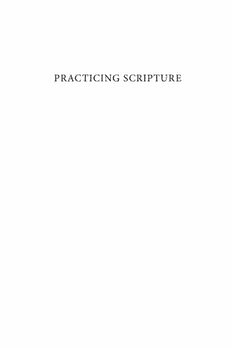
Practicing Scripture: A Lay Buddhist Movement in Late Imperial China PDF
Preview Practicing Scripture: A Lay Buddhist Movement in Late Imperial China
PRACTICING SCRIPTURE PRACTICING SCRIPTURE A Lay Buddhist Movement in Late Imperial China . Barend J. ter Haar University of Hawai‘i Press HONOLULU © 2014 University of Hawai‘i Press All rights reserved Printed in the United States of America 19 18 17 16 15 14 6 5 4 3 2 1 Library of Congress Cataloging-in-Publication Data Haar, B. J. ter, author. Practicing scripture : a lay Buddhist movement in late imperial China / Barend J. ter Haar. pages cm Includes bibliographical references and index. ISBN 978-0-8248-3927-7 1. Wuwei jiao (Sect) 2. Buddhist laymen—China—History. 3. Buddhism—China—History. I. Title. BQ9242.H33 2014 294.3'92—dc23 2014013014 University of Hawai‘i Press books are printed on acid- free paper and meet the guidelines for permanence and durability of the Council on Library Resources. Designed by Erika Arroyo Printed by Sheridan Books, Inc. . To my ancestors and my living kinsfolk Th ey matter Contents . Ac know ledg ments ix Introduction 1 Patriarch Luo: From Soldier to Religious Teacher 12 Charismatic Teachers against the Current 50 Spirited Debates and Sudden Conversions 85 Religious Beliefs and Ritual Practices 118 Th e Routinization of Charisma 151 Th e Movement under Duress 189 Rediscovering Lay Buddhism 219 Notes 235 Bibliography 273 Index 291 Ac know ledg ments . As I researched and wrote this book, I incurred many debts. Some I have prob- ably forgotten, and I sincerely apologize to those who are not mentioned as a result. Some debts I still recollect vividly, and I would like to list them here. My debt to the Taiwanese scholar Wang Jianchuan is the most important of my intel- lectual debts. His own research on the Dragon Flower Gathering on Taiwan was extremely important to me, but he has also set an example for all of us working in the fi eld by his ongoing eff orts to make rare primary sources on local religious culture available to the scholarly community. Over the last few years, I have prof- ited from having some exceptionally able students at Leiden University with whom I could talk through my intellectual and empirical concerns. I would es- pecially like to mention Yves Menheere (now a PhD student at Taiwan National University). My former colleague in Leiden, Jonathan Silk, also provided very important comments on the fi rst two chapters of this book. Paul Katz, as a reader on behalf of University of Hawai‘i Press, has been as incisive as ever, and Glen Dudbridge, one of my pre de ces sors in Oxford, made a crucial comment during a talk. Pauline Brereton again edited my En glish, for the fourth time. As always, this book could not have been written without access to various libraries. On this occasion, I was able to profi t from the library of the Sinological Institute at Leiden University (for most of the project), as well as the library of the Institute for Chinese Studies at Oxford University (for the fi nal stages). Th e staff s of both institutions were extremely helpful in meeting my requests for materials. A special thanks is due to the Berlin State Library (Staatsbibliothek Berlin) for what must be one of the most generous long- distance loan schemes anywhere in the world. I began my intellectual journey in this domain as a PhD student at Leiden more than two de cades ago, in the days before e-mail and Skype, when one could communicate only by snail mail or at conferences (if one could aff ord to attend them). At the time, I felt intellectually enormously stimulated and supported by Susan Naquin (then at the University of Pennsylvania and now at Prince ton Uni- versity), from whom I received many handwritten letters commenting on the evolving manuscript that was eventually to become my dissertation and fi rst book. Once more, I wish to express my sincerest thanks to her. Similarly, getting to know Hubert Seiwert (at Leipzig University) many years aft erwards was a ix x Acknowledgments special plea sure, not least because of his important contribution to religious free- dom in Germany. I also received various valuable comments and materials from his PhD student Nikolas Broy. Th is book could have included even more discussion, especially on the very recent past and present situation of the movement, including its ritual practices. I hope to address some of these lacunae elsewhere. For now, this book must stand as it is: a detailed treatment of the social and religious history of a single religious movement from the late sixteenth century into the middle of the twentieth cen- tury. I hope that I have been able to present all of this information— on what I fi nd a fascinating social and religious phenomenon— in a way that is useful and revealing. Many fl aws still remain, some of which I might have addressed, had I been more perceptive or spent even more time on the book; others are the result of personal editorial and intellectual decisions. None of these fl aws should be blamed on the readers mentioned earlier, for they have done their very best to protect me against mistakes.
